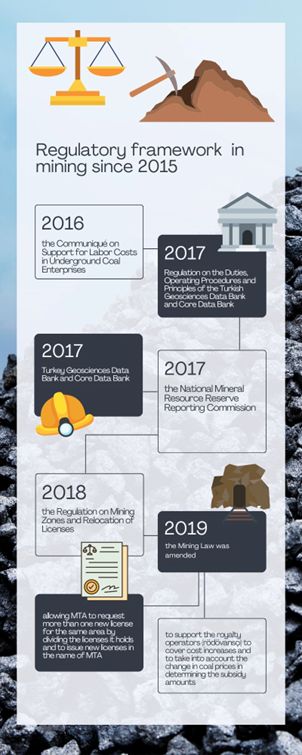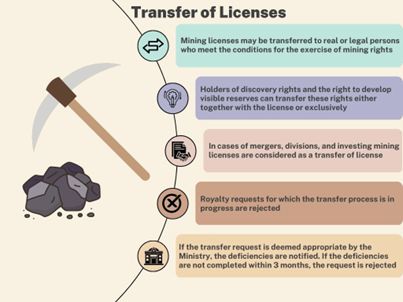- within Energy and Natural Resources, Tax and International Law topic(s)
- with readers working within the Aerospace & Defence, Banking & Credit and Media & Information industries
Mine the Gap: Recent Amendments in the Mining Regulation
The share of the mining sector in Türkiye's gross domestic product ("GDP") has been showing an increasing trend since 2016, reaching 1.3% in 20211. Although mining activities have been governed primarily by the Mining Law since 19852, the escalation after 2015 is due to the amendments made in the regulatory framework.

Following the above, the Communiqué on Support for Labor Costs in Underground Coal Enterprises, published in 2016, was regulated to support the cost increases in "Lignite" and "Hard Coal" underground mining companies. Moreover, with the "Regulation on the Duties, Operating Procedures and Principles of the Turkish Geosciences Data Bank and Core Data Bank" published in 2017, data and samples produced during mineral exploration, research, and production were archived and made available for use, thus facilitating access to the information needed. "Turkey Geosciences Data Bank and Core Data Bank" was established to prevent repetitive drilling in the same region, to add a third dimension to research, and to ensure effective, efficient, and economical use of public resources. Also in 2017, the National Mineral Resource Reserve Reporting Commission (Ulusal Maden Kaynak Rezerv Raporlama Komisyonu, "UMREK") was established to create clear and reliable resource and reserve information on the exploration, research, and production of minerals and to determine the reporting standards and criteria. In 2018, the Regulation on Mining Zones and Relocation of Licenses was published to implement the mining zone practice. In 2019, the Mining Law was amended to allow the General Directorate of Mineral Research and Exploration (Maden Tetkik ve Arama Genel Müdürlügü, "MTA") to request more than one new license for the same area by dividing the licenses it holds and to issue new licenses in the name of MTA. Finally, it was made possible to support the royalty operators (rödövansçi) to cover cost increases and to take into account the change in coal prices in determining the subsidy amounts.
Through the end of 2022, the former Mining Regulation was repealed, and several amendments were introduced by the new provisions. In this regard, we provide you with a thorough analysis of what the new Mining Regulation introduces in the following sections of this piece.
What did the new regulation change?
License Applications
In line with the provision regulating mining rights, the first application, exploration license, discovery (buluculuk), and operating license rights established on mines cannot be divided into shares. With the new Regulation, visible reserve development right (görünür rezerv gelistirme hakki)3 was also added to this share division restriction. Moreover, discovery and visible reserve development rights must be recorded in the mining registry for information. Transfer, conveyance, abandonment, or license cancellation does not remove the exploration and visible reserve development rights recorded in the registry.
Group III minerals (salts, gases other than natural gas) were granted exploration licenses. Group V minerals (precious and semi-precious minerals such as diamonds) were granted exploration certificates through tenders. With the new regulation, the exploration certificate has been abolished. Consequently, Group V minerals are also granted exploration licenses.
For Group II (b)4 and Group IV5 mines, if the part of the requested area is within certain areas notified to the MAPEG by the relevant institutions6, the applicant is given one year to obtain relevant permissions from the relevant institutions for these areas. If the stated permissions could not be obtained within this period, the application was rejected and would become open for applications. However, pursuant to the new regulation, another tender will license this area. Moreover, the new regulation also regulates partly taken permissions. In this regard, if permission has been obtained for a part of these areas, the unpermitted parts are subtracted from the application area, and this subtracted area is opened for a tender.
Under both former and new mining regulations, the mineral exploration project must include the following points:
- The content of the mineral exploration project
- Mineral exploration project activity adequacy
- Adequacy of mineral exploration project investment amount
- Deadline plan and its adequacy
- Financial capability
As per the financial capability, license applicants must submit the financial adequacy certificate for each license request. The new regulation states that the financial adequacy certificate is valid only if submitted to the General Directorate of Mining and Petroleum Affairs (Maden ve Petrol Isleri Genel Müdürlügü, "MAPEG") within fifteen days from the date of issue.
Exploration License Periods
Mining rights are granted through licenses which enable the license holders to engage in mining activities. For example, exploration rights are granted to conduct mineral exploration activities consisting of three main periods: preliminary exploration, general exploration, and detailed exploration7.
Under the new Regulation, it is explicitly regulated that the last day of the current period is accepted as the start date of the next exploration period. Further, during the exploration periods, it is obligatory to submit invoices, expense vouchers, salary payments, and documents related to other expenditures separately. If any discrepancy is found in the expenditure declarations related to the activities, the expenditures must be documented. If the deficiencies/discrepancies are not completed within the given period, administrative fines and license revocation sanctions are imposed.
The detailed exploration period, which is four years starting from the end of the general exploration period in Group IV mines, was regulated formerly like the following:
"It covers the studies carried out to calculate the quantity, density, shape, physical properties, grade/quality, and mineral content at a high level of reliability. During this period, which lasts for four years, it is necessary to carry out a sufficient number and frequency of outcrops, shafts, pits, drills, and galleries to reveal the mineral deposit in three dimensions and to make calculations at a high level of reliability. Sampling is carried out in sufficient numbers and frequency. The boundaries of the mineral deposit and the aforementioned characteristics of the mineral deposit are determined based on the data obtained by testing and analyzing the samples, the resource is calculated, and the characteristics for the operation of the mineral deposit are also determined."
The decision of the Council of State annulled this provision8. The reasoning behind this annulment was that it was necessary to determine which studies would be carried out based on a scientific study/report during the mining exploration period and preliminary investigation report stages and which branches of engineering were authorized to prepare project and activity reports related to the exploration periods. Without such a study and report, it was found to be against the law to give priority to geological engineers and to cause arbitrariness in using geophysics science. The annulled provision was added again to the foregoing Article, but this time the first sentence became like the following:
"It covers the studies carried out, also by utilizing geophysical studies, to calculate the quantity, density, shape, physical properties, grade/quality, and mineral content at a high level of reliability."
In the former provision governing the evaluation of operating license requests for certain mines9, the annual production amount declared in the operating projects could not be below the amount that meets the break-even point (basabas noktasi)10. The new regulation removed this requirement, and it is evaluated that this might be a positive development for mining operations in the long run. However, MAPEG is still authorized to determine the minimum annual production amounts according to various criteria. Moreover, as to the operating license requests, if the mine subject to the operating project is not made visible until the end of the exploration license period, the operating license request is rejected, and the exploration license is canceled. On the other hand, in addition to this provision, it is introduced that the operating license request made by revealing visible reserves for a different mine in the same group before the end of the exploration license period would be re-evaluated.
License Extensions
To initiate the procedures for the extension of the operating license period, the operating project must be submitted to MAPEG at least 1 year before the expiry date of the license. License holders who fail to comply with this obligation become subject to administrative fines. The license is canceled at the end of the license period if the specified obligations are not fulfilled until at least six months before the end of the operating license. The relevant area becomes eligible for a new operating license through a tender.
In case the lawsuits filed against the license revocation process are concluded in favour of the license holder:
- Licenses with the right to request an extension of time on the date the license is cancelled or that have less than six months to expiry will be given six months to request an extension.
- The license will be canceled if no request is made within the given six-month period.
- If the whole calendar year is spent in the court process, State rights, license fees, fees, and environmental compliance guarantees for those years will not be collected.
- If all conditions for extension are met, the operating license will be extended for ten years.
Transfer of Licenses
Mining licenses may be transferred to real or legal persons who meet the conditions for exercising mining rights. Under the repealed Regulation, holders of discovery rights could only transfer these rights with the license. However, according to the new Regulation, holders of discovery rights and the right to develop visible reserves can transfer these rights with the license or exclusively.
In mergers, divisions, and investing mining licenses as capital in the company within the meaning of the Turkish Commercial Code, there is a change of license holder. Therefore, with the new Regulation, these transactions are considered as a transfer of license, and consequently, the base fee of the operating license and the license transfer fee is charged.
As per the repealed Regulation, the transfer requests of the licenses would not be carried out if the transferee does not give a letter that he/she accepts the royalty agreement. This letter requirement now only applies to the royalty agreements recorded in the mining registry records. Further, the new Regulation states that royalty requests for which the transfer process is in progress are rejected.

Finally, if the transfer request is deemed appropriate by the Ministry of Energy and Natural Resources, the deficiencies related to the transfer request are notified. The transfer request is rejected if the notified deficiencies are not completed within 3 months.
Abandonment of Licenses
During the term of the license, the abandonment of all or part of the field can be requested by the license holder or his authorized representative. Within the scope of amendments introduced by the new Regulation, abandonment requests must be made with a notarized declaration for licenses belonging to natural persons and a notarized decision of the board of directors for licenses belonging to legal entities.
The abandonment request is evaluated if the following cumulative conditions are met:
- The license holder has paid the annual license fees, environmental compliance guarantees, administrative fines imposed
- There is no accrued and overdue State right debt as of the date of the request,
- An activated registered electronic mail address (elektronik posta adresi, "KEP") or national electronic notification system (ulusal elektronik tebligat sistemi, "UETS") address belonging to the license holder
- The appointment of a permanent supervisor has been made in licenses with operating permits
- The existence of an authorized legal entity contract
- There are no deficiencies in the technical documentation.
In the areas where partial rehabilitation will be carried out and in the license area that has been abandoned for any reason or has been requested to be abandoned, necessary measures must be taken without delay by the license holder or raw material production permit holder to ensure the safety of life and property. Otherwise, all responsibility belongs to the license holder or raw material production permit holder.
Opening of new quarries and change of operation permit area is not allowed in cases where:
- The rehabilitation of the areas where the old quarries with exhausted visible reserves are not started or
- A commitment is not given that the rehabilitation will be completed within the period determined by MAPEG without interruption.
Production activities would be suspended until the rehabilitation is completed at the sites where it is determined that the commitment has been violated.
State Rights
State right increased by 0.5%, reaching 4.5% for Group II (b) mines, based on the market sales price at the quarry according to the characteristics of the natural stone and the region where it is located. State rights rates may be changed by the President of the Republic of Türkiye by a maximum of 25% (downwards or upwards), considering the type of mine, the region where it is produced, and similar criteria.
Tüvenan ore (extracted directly from the mine without processing) can be processed into semi-finished or finished products. 50% of the State right is waived for those who process the ore in their facilities within Türkiye and provide additional added value. This incentive applies to 40% for gold, silver, and platinum.
For Group IV (c) minerals other than gold, silver, and platinum, 75% of the State right will not be collected in the following cases:
- The mine is converted into metal by the license holder in its integrated facilities in Türkiye; or
- It is declared that the mine is sold to domestic integrated facilities for processing into metal, and it is documented by the owners of the integrated facility that the mine is purchased to be converted into metal by specifying the quantity, grade, and average price.
Mining Registry
Within the repealed Regulation, the mining register could only be viewed by the license holder, the license holder's representative, and, in case of a transfer request, the transferee in the presence of an officer. It is now expressly stipulated that the mining registry is open and that any person whose interest is credible may request to see the registry records in the presence of one of the mining registry officers. It is governed that one cannot claim that the mining register's records are unknown. Therefore, a good faith argument would not be brought forward.
Royalty Agreements
License holders may conclude royalty agreements (rödovans sözlesmesi) to provide third parties with the right of disposal to process and utilize the minerals in their license areas. Royalty agreements between licensees and third parties are now subject to the permission of the MAPEG instead of the permission of the Ministry of Energy and Natural Resources in the previous legislative framework. Royalty agreements are entered into the registry records once authorized by the MAPEG.
Under the previous Regulation, all mining accidents occurring in the license areas had to be notified to the MAPEG by the license holder and the permanent supervisor. The new Regulation also obliges the royalty holder with the notification responsibility.
The former mining regulation imposed only a post-closing notification requirement for share transfers of more than 10%, leading to a change in the shareholding structure of a royalty holder. However, the new Regulation introduced prior approval from the MAPEG before completing the transfer. However, it might be argued that failure to obtain such approval from MAPEG before closing would not affect the validity of the share transfer if the company does not comply with the approval requirement within 2 months despite the administration's warning of an administrative fine around TRY 55 thousand (approx. EUR 2,800) would be imposed. Further, the authorities could also terminate the mining activities after 2 months. Despite an explicit provision for the timeline in relation to the prior approval from the MAPEG, as a general rule, if administrative authorities do not answer the requests within 30 days, the right to file an annulment action arises.
Supervision of a Mining Engineer
Operation activities in mining license areas (except for spring salts) are carried out under the supervision of a mining engineer. The new regulation clarified the obligation to appoint a separate single permanent supervisor in the following cases:
- Each underground quarry is independent of one other
- For open pit mines operated by different persons
- For independent open pits/quarries operated by the same person
- For quarries working in shifts
The permanent supervisor must notify the MAPEG of his/her activated KEP or UETS address.
Once the licenses are merged, the appointed permanent supervisor must continue his/her duty. If there exists more than one permanent supervisor, but one is sufficient, the licensee may reduce the number of permanent supervisors for each quarry within two months. If a reduction is not made by the licensee himself/herself, the duties of the later-appointed permanent supervisors are terminated. Finally, if it is necessary to appoint separate supervisors in merged sites, the duties of both continue.
Notifications
All notifications regarding the issues falling within the scope of the duty of the MAPEG can be notified to the relevant person via KEP or UETS address. Accordingly, adding the UETS address exceeds the scope specified in the Mining Law. The Mining Law also stipulates that license and rights holders must use an activated KEP address. The Regulation extends this obligation to UETS address. In line with the Mining Law provisions, those who fail to fulfill this obligation are also subject to administrative fines for every three months they fail to fulfill their obligations.
The new Regulation stipulates that license and rights holders are obliged to submit the UETS addresses to the MAPEG within three months from the publication date of the new Regulation (until 11.03.2023). Those who fail to submit their UETS addresses within this period are imposed an administrative fine.
Conclusion
As seen above, there is much to understand and digest in the new Mining Regulation. This article touched upon the most up-front changes that the new amendment brought in relation to the exploration certificates, financial adequacy certificates, exploration license periods, license extensions, transfer of licenses, abandonment of licenses, State rights, mining registry, royalty agreements, supervision of a mining engineer and notifications.
We will observe how the new provisions will affect the sector and what the compliance efforts look like. It is possible that after 2015, this amendment might result in a second wave of escalation.
Footnotes
1. https://www.mapeg.gov.tr/Custom/Madenistatistik , Last Accessed on 05.02.2023.
2. For a brief summary of Turkish Mining Law please see: https://www.mondaq.com/turkey/mining/959418/a-brief-summary-of-turkish-mining-law , Last Accessed on 05.02.2023.
3. Parallel to the Mining Law, under the new Mining Regulation visible reserve development right is defined as the share received by the real/legal persons and/or public institutions that reveal the visible reserves within the scope of the contract made between the license holder or the General Directorate and real/legal persons and/or public institutions regarding the tendered fields. Contracts for the visible reserve development right is recorded in the mining register for information purposes upon application to the General Directorate of Mining and Petroleum Affairs.
4. Stones produced as blocks such as marble, travertine, onyx marble, granite, andesite, basalt, diabase, stones that are sized and given geometric shape, and natural stones used for decorative purposes such as slate, slate, tuff, ignimbirite and similar natural stones.
5. Industrial raw materials, energy raw materials and metallic materials including gold and silver
6. Such as special environmental protection zones, national parks, wildlife protection and development areas, organized industrial zones, investment areas such as oil, natural gas and geothermal pipelines
7. Please see "A Brief Summary Of Turkish Mining Law" for more detail, https://www.mondaq.com/turkey/mining/959418/a-brief-summary-of-turkish-mining-law, Last Accessed on 09.02.2023.
8. Decision of the Eighth Chamber of the Council of State dated 19/1/2022 and numbered E.:2017/7299; K.:2022/64, https://www.lexpera.com.tr/ictihat/danistay/8-d-e-2017-7299-k-2022-64-t-19-1-2022, Last Accessed on 07.02.2023.
9. Group II (b), III, IV and V.
10. The point at which total cost and total revenue are equal.
The content of this article is intended to provide a general guide to the subject matter. Specialist advice should be sought about your specific circumstances.



